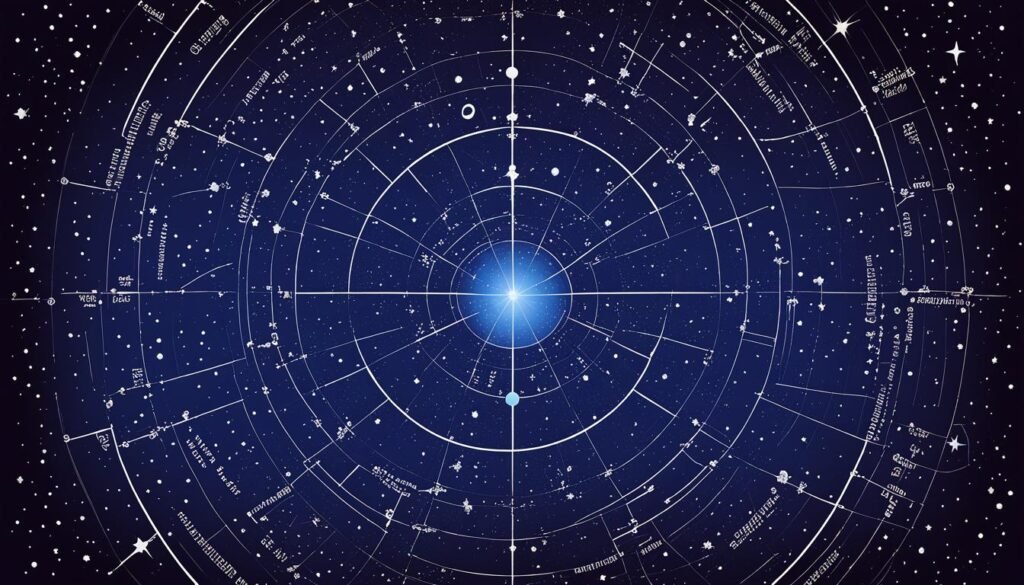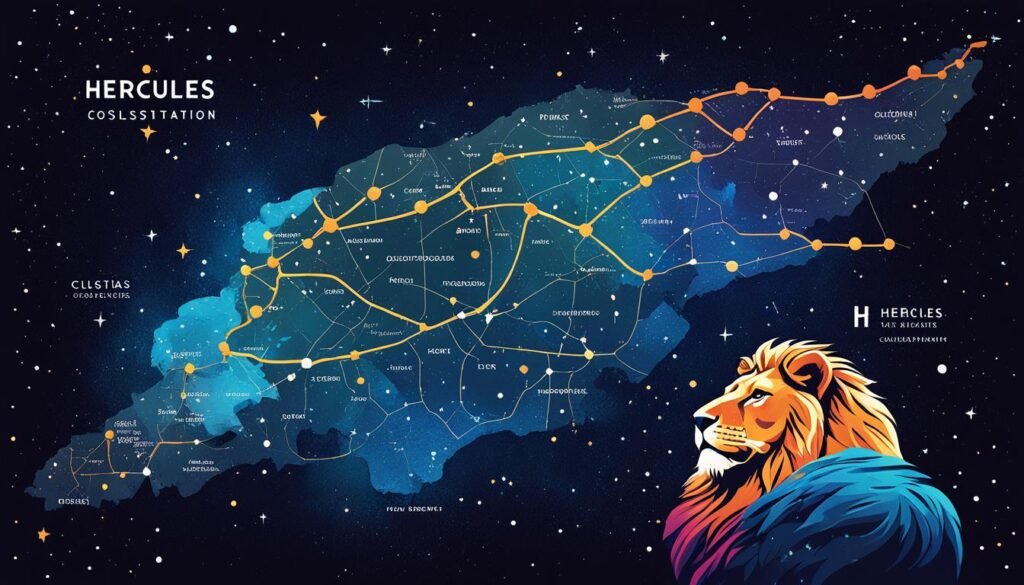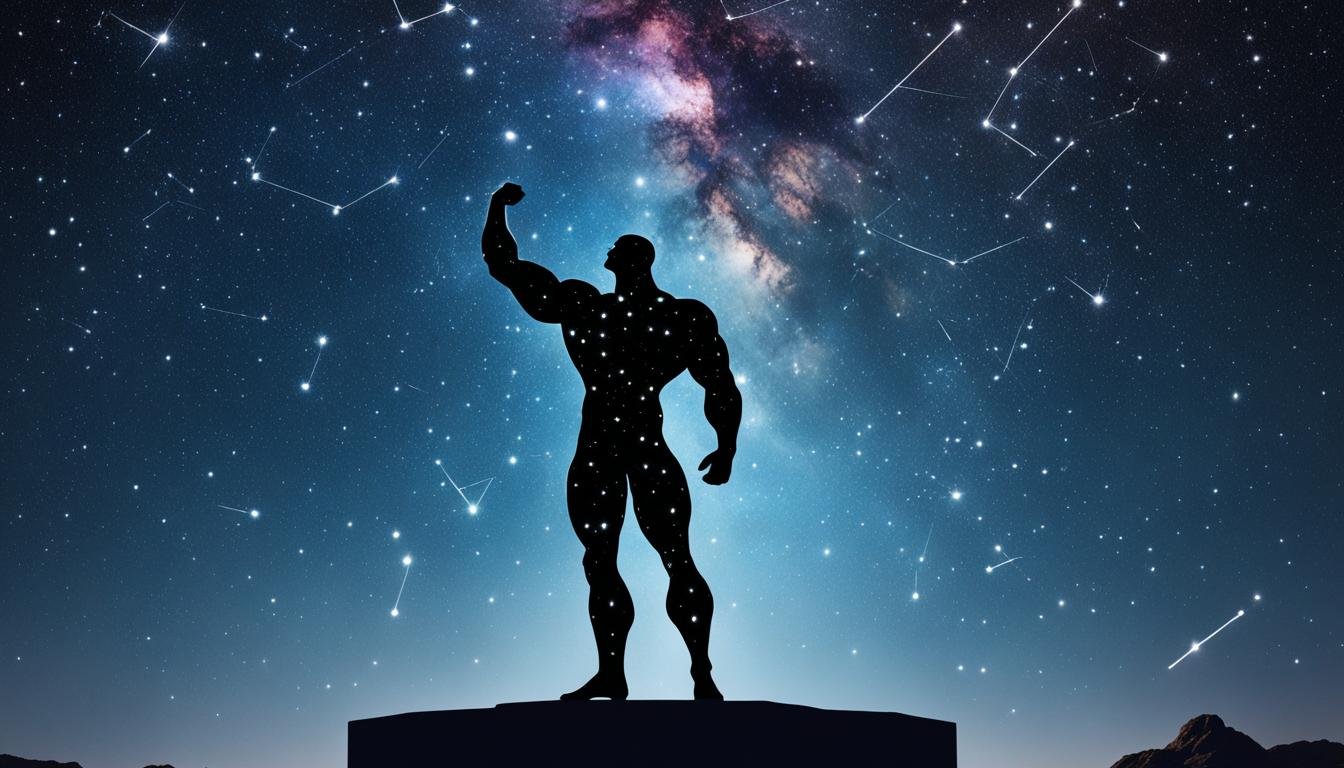| Genitive | |
| Abbreviation | |
| Pronunciation | |
| Main Stars | |
| Brightest Star | |
| Right Ascension | |
| Declination | |
| Sq. Deg. Area | |
| Crosses Meridian | |
| Visible Lat. Range |
Gaze upon the northern sky, and you might unravel the stellar enigma of the Constellation Hércules, embodying the valor of its mythological counterpart. This Hércules constellation guide will mark the stellar pathways leading to the understanding of this celestial behemoth. With no first magnitude stars to its name, its glory is understated, yet rich in celestial and mythological importance.
Tracing back to antiquity, the constellation spans a breathtaking 1225 square degrees, standing as the fifth largest in the night sky. Namesake of the mighty Hercules, the mightiest of the Roman adaptations of the Greek demigod Heracles, it resonates with countless stories embedded in the cosmos. Your journey through the Hércules star chart unveils not just a multitude of brilliant stars and deep-sky objects but with every twinkling light, a piece of the rich tapestry that is Hércules mythology is revealed. Hércules astrology enthusiasts will find the constellation’s influence permeates many a heroic tale, blending cosmic wonder with legendary narrative.
Dive deep into the celestial depths of the night sky as we present you with the most intricate Hércules constellation facts, perfectly crafted for both the seasoned astronomer and the starry-eyed novice. Prepare to embark on a cosmological odyssey that transcends the mere coordinates, unveiling the heroism painted against our vast universe.
Key Takeaways
- Discover the vast expanse and heroic association with the Constellation Hércules.
- Gain insight into Hércules constellation’s rich mythological context and astronomical significance.
- Explore the Keystone asterism and other notable features such as Ras Algethi within the Hércules star chart.
- Learn about the Great Globular Cluster (Messier 13) and other deep-sky wonders residing in Hércules.
- Uncover the best vantage points and times for observing the grandeur of this colossal constellation.
- Deepen your understanding of Hércules astrology and its role in celestial storytelling.
Unveiling the Constellation Hércules: A Celestial Legacy
As you gaze into the night sky, the substantial sprawl of Constellation Hércules offers stargazers an insightful glimpse into the celestial heritage that straddles the realms of astronomy and mythology. With a history as deep and intricate as the stars themselves, exploring the Hércules constellation is nothing short of a stellar odyssey.
The Astronomical Heritage of Constellation Hércules
Constellation Hércules, a beacon of tradition in the celestial sphere, is steeped in rich astronomical history. The unmistakable patterns recognized as Hércules star patterns emerge from the northern hemisphere’s canvas, available to observers from the most northerly latitudes to those as far south as -50°. With the International Astronomical Union’s designation as ‘Her’, this constellation forms an integral part of the Hercules family, mingling in the expanse with neighbors like Aquila and Lyra. Among the treasures within its borders are not only the fabled Messier objects M13 and M92 but also the astronomical spectacle of the Tau Herculids meteor shower, with the star Kornephoros shining as the brightest beacon.
Hércules Star Map: Tracing the Sky’s Mythical Hero
Delving into the Hércules star map, you will find a cartographic wonder that illustrates the Hércules constellation with precision and clarity. Marked with asterisms such as the Keystone, which allegorically outlines Hercules’ powerful torso, and the star Ras Algethi, symbolic of his head, this constellation map becomes an indispensable Hércules constellation guide for any aspiring astronomer or mythologist. The partnership of the International Astronomical Union with Sky & Telescope magazine ensures that this map serves as an educational tool that fuses ancient tales with modern-day star charting.
Deciphering Hércules’ Location: Coordinates and Visibility
Identifying the coordinates of the Hércules constellation is pivotal for tracing its celestial path. Positioned at 17h 00m 00s, +30° 00′ 00″, it ranks as the fifth-largest constellation in the night sky, occupying a voluminous 1225 square degrees. You can revel in the Hércules constellation’s splendor during optimal viewing times around 21:00 (9 p.m.) in July, with its 32-segmented polygon border setting the stage for an impressive display against the backdrop of the mid-northern latitudes. The incorporation of Hércules constellation facts and Hércules visibility times enriches your experience, ensuring you catch a glimpse of this mighty celestial figure at its prime.
| Hércules Constellation Key Facts | Details |
|---|---|
| Brightest Star | Kornephoros (Magnitude 2.81) |
| Visible Latitudes | +90° to -50° |
| Quadrant | Northern Hemisphere’s Third Quadrant |
| Area | 1225 Square Degrees |
| Optimal Visibility | 21:00 (9 p.m.) during July |
Hércules Star Patterns and Notable Features
As you cast your gaze skyward, the Hércules constellation serves as a beacon of mythological grandeur, with intricate patterns woven from stars that have guided humanity for millennia. Within its borders, distinctive star patterns and celestial wonders tell the story of Hercules, the ancient hero of strength and courage.
The Keystone: Gateway to the Mythical Hero
The Keystone asterism is a standout formation within the Hércules star chart, acting as an entryway to the tales of valor. This distinctive quadrangle is composed of the stars Pi, Eta, Zeta, and Epsilon Herculis, marking the mighty torso of Hercules. The Keystone not only epitomizes Hércules star patterns but also simplifies the identification of this legendary constellation’s overall shape.
Ras Algethi: The Heart of Hércules
Alpha Herculis, also known as Ras Algethi, is the pulsating heart within the Hércules constellation. This multiple star system, anchored by a resplendent red giant, shines brightly with a magnitude of 2.81. At an approximate distance of 359 light-years, Ras Algethi’s celestial glow captures the essence of Hercules’ enduring legacy within the vast universe.
Messier 13 and Messier 92: Hércules’ Celestial Jewels
The Herculean constellation boasts two deep-sky treasures: Messier 13 and Messier 92. Referred to as the Great Globular Cluster in Hercules, Messier 13 is an enthralling ball of stars that’s quite visible to the naked eye under favorable conditions, lying at a staggering distance of 25,200 light-years from Earth. Only slightly less luminous is Messier 92, another globular cluster whose stellar density and radiance are comparable, located 26,000 light-years away. These celestial jewels enrich the Hércules constellation, serving as cosmic reminders of the vastness of outer space.

| Feature | Description | Significance |
|---|---|---|
| The Keystone | Asterism of four stars forming Hercules’ torso | Navigational aid for locating other stars in the constellation |
| Ras Algethi (α Herculis) | Brightest star, a red giant | Represents the heart of the mythical hero |
| Messier 13 | Globular cluster visible to the unaided eye | Known as the Great Globular Cluster in Hercules, a prominent feature |
| Messier 92 | Dense globular cluster | Highly luminous, though fainter than M13 |
Mapping the Night Sky: Understanding Constellation Hércules
When you gaze upon the heavens, the Hércules constellation serves as a beacon for celestial explorers. Known for its wealth of history and breathtaking stellar formations, understanding this constellation’s layout is key to appreciating its grandeur. Let’s dive into the intricacies of the Hércules constellation, from its detailed star chart to seasonal viewing opportunities that maximize your stargazing experience.
The Mapped Heavens: Hércules Constellation Chart
With the Hércules star chart, navigating the vast night sky becomes an intriguing journey. This constellation map delineates the position and magnitude of Hércules’ stars, making it an indispensable tool for both amateur and seasoned astronomers. Education and precise charting approved by the International Astronomical Union (IAU) solidify the significance of these maps in studying the Hércules constellation facts that give life to the skies above.

Borders and Neighboring Constellations
The Hércules constellation borders a range of neighboring constellations, creating a mosaic-like architecture in the sky. Bounded by Edmond Halley’s calculations, Hércules shares its celestial domain with neighboring arrangements such as Draco to the north and Lyra to its west. This unique configuration, comprising an area of 1225.1 square degrees, offers a splendid tableau as these neighboring constellations enhance the majesty of the Hércules nighttime spectacle.
Hércules Seasonal Appearances and Best Viewing Times
As the seasons shift, so do your opportunities to witness the Hércules constellation in its full glory. With seasonal appearances that favor the mid-northern latitudes, Hércules is best viewed in July around 9 p.m., when its stars glitter brightly against the dark canvas. Mark your calendars for June 13, when Hércules culminates at midnight—providing optimal clarity for stargazers and solidifying its status as an astronomical marvel distinguished by its best times to view Hércules.
Constellation Hércules: A Tapestry of Astrological Significance
The Hércules astrology realm intertwines with the arresting Hércules mythology, mapping out a cosmic narrative that echoes the prowess and endurance of its eponymous hero. You may find yourself gazing at the night sky, tracing the Hércules star map with a sense of wonder, tapping into the astrological wisdom passed down through millennia.
Astrology enthusiasts often seek guidance from the constellations, and Hércules offers rich symbolism to draw from. As you align with its stellar formation, consider the virtues of valor and fortitude that Hércules epitomizes. Let’s delve into some of these symbolic resonances with a table that correlates aspects of Hércules’ story to astrological implications:
| Mythological Aspect | Astrological Implication | Modern Resonance |
|---|---|---|
| The Twelve Labors | Resilience in the face of adversity | Overcoming personal challenges |
| Nemean Lion | Courage to confront fears | Assertiveness and self-confidence |
| Hydra Battle | Transformation and renewal | Personal growth and adaptation |
| Golden Apples of the Hesperides | Pursuit of knowledge and enlightenment | Continuous learning and curiosity |
| Cerberus Capture | Understanding and accepting one’s darker side | Self-awareness and emotional intelligence |
By immersing yourself in the legacy of Hércules mythology and its astrological undertones, you are not just connecting with a cluster of distant suns; you are partaking in a heritage that champions the human spirit. The Hércules star map is more than a guide—it’s a reflection of our collective journey through the tapestry of life.
The Mythological Tapestry of Hércules
The firmament above narrates an imperishable saga through the Hércules constellation; a saga intricately embroidered with the heroics and tribulations of its namesake. The stories crafted in the celestial hemisphere speak of Hércules’ divine lineage and the numerous marvellous undertakings that earmarked his life. It’s in the configuration of stars where one can trace Heracles’ bloodline to Zeus, presenting a testament to the potency and divinity that pulsated through his veins. As you delve deeper into Hércules mythology, you encounter the Herculean feats that were his Twelve Labours, epics of might and resilience etched against the cosmos. Each labor represents a chapter of struggle and triumph, a sequence that journeys through the mythological labyrinth to bestow insight into the essence of this storied demigod.
In your exploration of the night sky through a Hércules constellation guide, you become enveloped in the enigmatic grandeur of Hércules’ battles. These celestial scuffles reflect his clashes with formidable opponents such as the Nemean lion and the Lernaean Hydra, creatures immortalized in neighboring constellations like Leo and Cancer. Even as the stars narrate tales of conflict and conquest, they also evoke the sorrow and redemption that forged the hero’s legend, revealing the multifaceted nature of his existence, marked by human strife and the quest for absolution.
Your perception of this mythological firmament expands further when recognizing the Constellation Hércules as a historical homily to an icon’s valor. Each star in this majestic spread of celestial real estate, each nebulae and cluster, stand as a tribute to Heracles’ eternal narrative. His actions, not just a lesson in mythology but also a source of inspiration, encourage one to ponder the full circumference of human potential and the glory that lies in overcoming adversity. In observing Hércules’ eternal repose in the heavens, you recognize the constellation as a symbolic apparatus for mortal aspiration and an enduring symbol of the heroic spirit.
FAQ
What is the Constellation Hércules known for?
The Constellation Hércules is known for being the fifth largest constellation in the sky, its lack of first magnitude stars, and its rich mythology tied to the Roman hero Hercules. It also houses the Great Globular Cluster, Messier 13.
Where is the Constellation Hércules located in the sky?
Constellation Hércules is located in the northern hemisphere’s third quadrant and is best viewed at latitudes between +90° and -50°. Its coordinates are 17h 00m 00s, +30° 00′ 00″.
Which stars form the Keystone asterism in the Constellation Hércules?
The Keystone asterism is formed by four stars: Pi, Eta, Zeta, and Epsilon Herculis, representing the mythological hero’s torso.
What is special about Ras Algethi?
Ras Algethi, also known as Alpha Herculis, is the brightest star in the constellation and a complex system of three stars, with the primary being a bright giant. It symbolizes the heart of Hercules.
Can you see Messier 13 with the naked eye?
Yes, Messier 13, also known as the Great Globular Cluster in Hércules, can be seen with the naked eye under clear dark skies.
What are the best times to view the Constellation Hércules?
The best time to view the Constellation Hércules is around 9 p.m. in the month of July. The constellation is most visible in mid-northern latitudes from mid-spring to early autumn.
Who catalogued the Constellation Hércules and when?
The Constellation Hércules was first catalogued by the Greek astronomer Ptolemy in the 2nd century.
What does the Hércules Constellation represent in astrology?
In astrology, the Constellation Hércules represents themes of strength, heroism, and perseverance, reflecting the characteristics of its mythological namesake, Hercules.
How does the mythology of Hercules relate to the constellation?
The mythology of Hercules, known for his strength and Twelve Labours, is reflected in the constellation’s name and its presence in the sky. The constellation serves as a celestial monument to Hercules’ heroic deeds and his place among the gods.
Which constellations border Hércules?
Constellation Hércules is bordered by several constellations, including Draco to the north, Lyra to the west, and others like Bootes, Ophiuchus, and Serpens Caput.
What is the brightest star in the Constellation Hércules?
The brightest star in the Constellation Hércules is Kornephoros, also known as Beta Herculis, with an apparent magnitude of 2.81.
Are there any meteor showers associated with Constellation Hércules?
Yes, the Tau Herculids meteor shower is associated with the Constellation Hércules.






